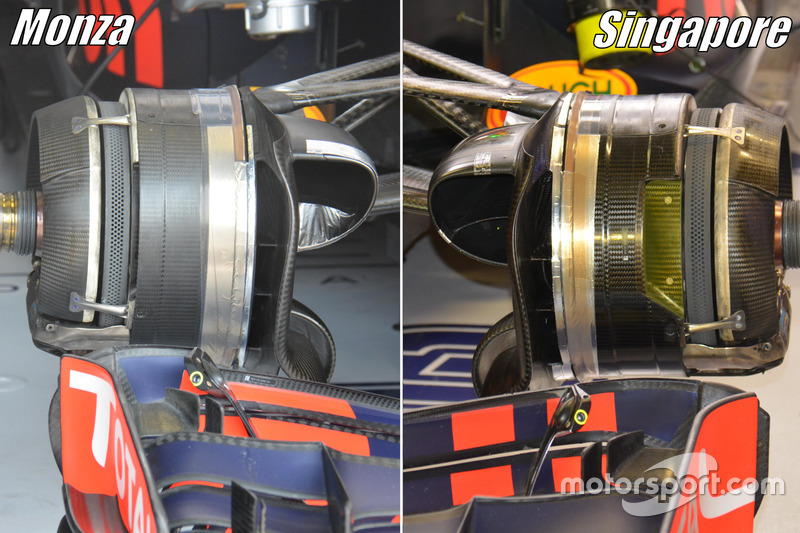Bite-size tech: Red Bull RB12 front brake drum
Red Bull continues to refine its front brake drum set-up with a further adjustment being trialled at Austin in free practice.

Photo by: Giorgio Piola
Giorgio Piola's F1 technical analysis
Giorgio Piola is the preeminent Formula 1 technical journalist. View our full selection of Giorgio's technical illustrative content
The team introduced a new less restrictive brake drum concept in Italy (above, left) and has spent time refining it ever since, including the inclusion of crossover pipework in Singapore (above, right).
In Austin the team is paying attention to the drum once more, such is the performance benefit of controlling the way heat radiates from the brakes, through the wheel rim into the tyre.
An additional panel has been placed above the brake disc (arrowed) with several slots in its surface that allow air in to cool the disc.
It should be noted that this is an asymmetric layout, with the slotted panel only placed in the front right drum. This is of particular importance considering that Circuit of the America’s is one of the handful of circuits run counter-clockwise.
This means that the front right takes the most punishment as the car's weight shifts through the corners, putting a more severe heat cycle through the tyre.
Managing this heat cycle is critical to direct performance and stint length, something that could put Red Bull on par with the Mercedes duo.
Red Bull has also taken the opportunity to do some correlation work in Austin, with a small army of kiel probe arrays mounted to the RB12 to take measurements during some of Friday’s free practice running.
These kiel probe arrays were placed behind the front suspension and tyres in order to get an understanding of how the air is distributed around the front of the car, so that the real-world information can be checked off against their simulation tools back at the factory.
Having the CFD and scale wind tunnel models producing representative data is imperative to gaining performance, and with the 2017 design now pretty much fully formed, it’s essential that the team knows everything is working in harmony - otherwise it may be forced to change its designs.
Be part of Motorsport community
Join the conversationShare Or Save This Story
Subscribe and access Motorsport.com with your ad-blocker.
From Formula 1 to MotoGP we report straight from the paddock because we love our sport, just like you. In order to keep delivering our expert journalism, our website uses advertising. Still, we want to give you the opportunity to enjoy an ad-free and tracker-free website and to continue using your adblocker.





















Top Comments